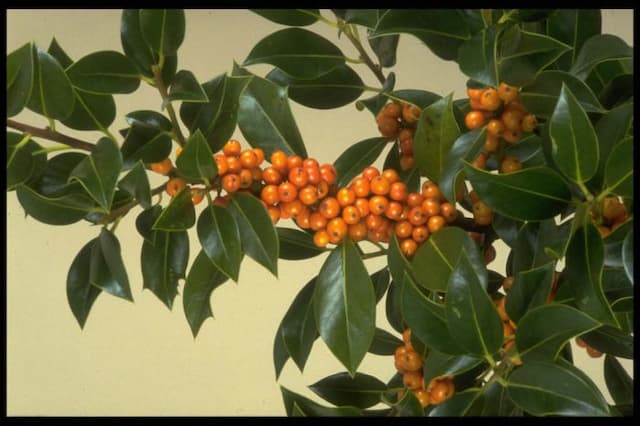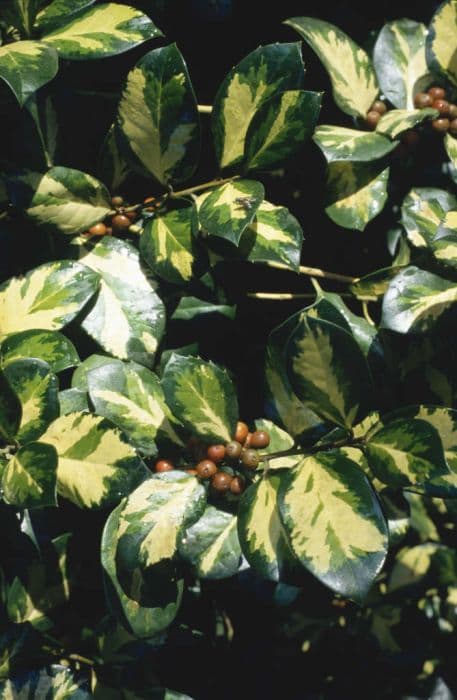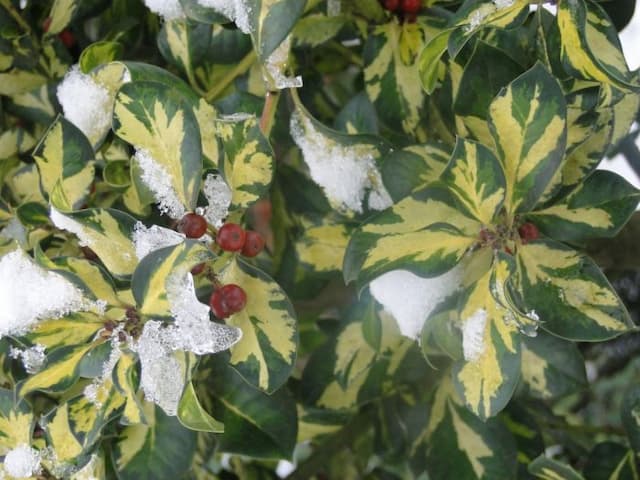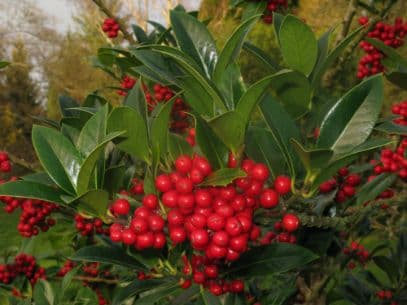Lydia Morris Holly Ilex 'Lydia Morris' (f)

ABOUT
Ilex 'Lydia Morris' is commonly known as the Lydia Morris Holly. It is a female variety recognized for its glossy, dark green foliage and its ability to produce berries. Each leaf on the Lydia Morris Holly exhibits a classic holly shape with a series of spiky points along the edges, which can be both visually striking and somewhat prickly to touch. It is the texture and sheen of the leaves that often catch someone's eye, giving the plant a lustrous appearance amidst garden greens. During the blooming season, small white flowers may appear. Being a female cultivar of the holly species, if this plant is situated near a male pollinator, it will often produce vivid red berries. These berries are a signature trait of hollies, adding a splash of color, especially noticeable in the winter months, and providing an important food source for birds and wildlife. The Lydia Morris Holly, while missing its sizeable dimensions in this description, forms into a robust plant with a dense, bushy appearance, offering a good option for hedges or as an ornamental feature in a garden due to its ability to maintain a full, symmetrical shape. The rich color and potential berry production make it a valuable addition to various landscape designs, providing year-round interest and seasonal color variation.
About this plant
 Names
NamesFamily
Aquifoliaceae.
Synonyms
Lydia Morris Holly.
Common names
Ilex 'Lydia Morris'
 Toxicity
ToxicityTo humans
Ilex 'Lydia Morris' is more commonly known as a type of Holly. Holly berries and leaves can be toxic to humans if ingested. The primary toxic components are theobromine, an alkaloid that is also found in chocolate, and saponins, which are glycosides. Symptoms of holly poisoning may include nausea, vomiting, diarrhea, and abdominal pain. In severe cases, it can also lead to drowsiness, dehydration, and in very rare circumstances, can be potentially life-threatening due to the risk of dehydration from gastrointestinal symptoms.
To pets
Holly, of which Ilex 'Lydia Morris' is a cultivar, is also toxic to pets, including dogs and cats. The toxic principles are the same as those that affect humans - theobromine and saponins. If pets consume holly leaves, berries, or bark, they may experience symptoms such as vomiting, diarrhea, loss of appetite, and excessive drooling. In severe cases, holly ingestion can lead to potential dehydration, tremors, or seizures. It is essential to keep holly plants out of the reach of pets and to consult a veterinarian immediately if ingestion occurs.
 Characteristics
CharacteristicsLife cycle
Perennials
Foliage type
Evergreen
Color of leaves
Green
Height
8-10 feet [2.4-3 meters]
Spread
6-8 feet [1.8-2.4 meters]
Plant type
Shrub
Hardiness zones
5-9
Native area
North America
Benefits
 General Benefits
General Benefits- Ornamental Appeal: The Ilex 'Lydia Morris' adds visual interest to gardens with its glossy green leaves and red berries.
- Wildlife Habitat: The berries provide a food source for birds, especially in winter when food is scarce.
- Privacy Screen: It can be used to create hedges or screens, offering privacy and reducing noise pollution.
- Low Maintenance: Once established, it requires minimal care and is relatively drought-tolerant.
- Versatility: Suitable for a variety of landscapes, including formal gardens and natural areas.
- Tolerance to Shade: It grows well in partial shade, allowing for flexible planting in different garden areas.
- Seasonal Interest: Provides year-round interest with evergreen foliage and seasonal berries.
 Medical Properties
Medical PropertiesThis plant is not used for medical purposes.
 Air-purifying Qualities
Air-purifying QualitiesThis plant is not specifically known for air purifying qualities.
 Other Uses
Other Uses- Ilex 'Lydia Morris' can be used in topiary gardens due to its dense foliage and ability to withstand pruning and shaping into various forms.
- Its woody branches can be harvested and used in floral arrangements to add structure and a touch of greenery.
- The plant's dense growth habit makes it suitable for use as a sound barrier to reduce noise pollution in urban areas.
- Dried leaves of Ilex 'Lydia Morris' can be used to create natural dyes for coloring fabrics or other materials.
- Its red berries can be used as natural food coloring or decoration in culinary presentations.
- Leaves from this holly can be used to craft holiday wreaths and other festive decorations during the winter season.
- The dense foliage can be utilized as a protective shelter for small wildlife in gardens, such as birds and beneficial insects.
- Holly wood, including that from Ilex 'Lydia Morris', is traditionally used for making walking sticks and staffs.
- The plant can be employed as part of a landscape design to create an outdoor labyrinth or meditation garden.
- Its sturdy form and evergreen leaves make it a suitable candidate for bonsai cultivation.
Interesting Facts
 Feng Shui
Feng ShuiThe Holly is not used in Feng Shui practice.
 Zodiac Sign Compitability
Zodiac Sign CompitabilityThe Holly is not used in astrology practice.
 Plant Symbolism
Plant Symbolism- Protection: Ilex, commonly known as holly, often symbolizes protection due to its spiky leaves, which ancient peoples believed could ward off evil spirits.
- Good Fortune: Holly is considered a plant that brings good luck, especially around the holiday season, as it is often associated with Christmas and its tradition of bringing in good tidings.
- Eternal Life: The evergreen nature of holly signifies eternal life, reflecting the plant's ability to withstand the winter and remain vibrant throughout the year.
- Hope: Holly's ability to endure the coldest periods and remain evergreen is considered a sign of hope, symbolizing resilience and the promise of renewal.
 Water
WaterHolly 'Lydia Morris' should be watered thoroughly when the top inch of soil feels dry to the touch, which typically means once or twice a week depending on the climate and soil drainage. It is important not to overwater as this can lead to root rot. In general, provide about 1 gallon of water per session for a young plant, increasing the amount as the plant grows and establishes. During the first growing season, ensure consistent watering to help establish a strong root system. Adjust watering frequency during extreme temperatures or unusually dry or wet seasons.
 Light
LightHolly 'Lydia Morris' thrives in full sun to partial shade. The best location for this holly is a spot where it receives at least 4 to 6 hours of direct sunlight per day but is also protected during the hottest part of the day if in a particularly hot climate. Too little light can lead to sparse foliage and fewer berries, so choosing a bright spot is vital for the plant's health and aesthetic appeal.
 Temperature
TemperatureHolly 'Lydia Morris' is hardy and can tolerate a wide range of temperatures but prefers a range between 40 and 70 degrees Fahrenheit for optimal growth. This holly can survive minimal temperatures down to about -10 degrees Fahrenheit but may experience damage at those extremes. The plant should also be shielded from harsh winter winds which can lead to desiccation, especially in the colder end of its range.
 Pruning
PruningPruning Holly 'Lydia Morris' is usually done to shape the plant or maintain size but is often unnecessary if the plant has ample space to grow. If pruning is desired, it should be carried out in late winter or early spring before new growth begins. This holly can also be pruned after its berries have faded if you wish to use them for decorative purposes. Pruning every 2 to 3 years helps to keep the plant looking tidy and can encourage more vibrant growth.
 Cleaning
CleaningAs needed
 Soil
SoilThe best soil mix for Holly 'Lydia Morris' is one that is well-draining and rich in organic matter. A blend of loam, peat moss, and sand in equal parts can provide a suitable environment for its roots. The soil pH should be slightly acidic, ideally between 5.0 and 6.0, to ensure healthy growth and nutrient absorption.
 Repotting
RepottingHolly 'Lydia Morris' should be repotted every 2-3 years to ensure the roots have adequate space to grow. Younger plants may require more frequent repotting, while mature plants can be repotted less often. Always use fresh soil mix when repotting to replenish nutrients.
 Humidity & Misting
Humidity & MistingHolly 'Lydia Morris' will thrive in moderate to high humidity levels. Aim for a humidity level between 40% to 60%. If indoor air is too dry, especially during winter months, consider using a humidity tray or a room humidifier to maintain the optimal range.
 Suitable locations
Suitable locationsIndoor
Place in bright, indirect light and keep soil consistently moist.
Outdoor
Plant in partial shade, sheltered from strong winds and frost.
Hardiness zone
5-9 USDA
 Life cycle
Life cycleIlex 'Lydia Morris', commonly known as holly, begins its life cycle with seed germination, which typically occurs in the spring following the dispersal of berries from a female plant, often assisted by birds. The seedling stage follows, where the young plant establishes a root system and begins to produce its iconic spiky green leaves. As the plant matures into the vegetative stage, it exhibits strong growth through multiple seasons, developing a woody stem and branching out. Sexual maturity is reached after several years, when the holly is able to produce its own flowers—usually small, white blooms that are followed by red berries on female plants, provided there is a male plant nearby for pollination. Once mature, the holly enters a long reproductive phase, where it can continue to grow and produce flowers and berries for many years. The life cycle concludes with the plant's eventual senescence and death, although hollies can live for several decades under optimal conditions.
 Propogation
PropogationPropogation time
Spring-Early Summer
Propogation: The Ilex 'Lydia Morris', commonly known as a cultivar of Holly, is typically propagated by means of cuttings. The most popular method is taking semi-hardwood cuttings in late summer to early fall. Cut a 4 to 6-inch (10 to 15 cm) long stem piece from the current year’s growth, and remove the lower leaves to expose the nodes. Dip the cut end into a rooting hormone to encourage root development, then plant the cutting in a well-draining potting mix. Cover the pot with a plastic bag or place it in a propagator to maintain high humidity, and keep it in a warm area with indirect light. Roots generally appear in a few weeks, after which the new Holly plant can be gradually acclimated to less humid conditions before being planted out in the garden after the last frost has passed.









